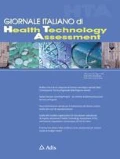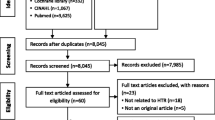Abstract
Background
The involvement of stakeholders (internal — third party payers, health care organisations and research centres, external — industry and patients, and clinicians) by HTA Organisations is hugely debated. On the one hand their participation may provide important information for the assessment process and could promote consensus over recommendations. On the other hand stakeholders’ involvement increases complexity in the decision-making process. The actual role of stakeholders and reasons for their different involvement in HTA organisations have not been deeply scrutinised so far. The aim of this paper is to investigate these two issues in six European countries, with a focus on those HTA organisations that assess medical devices (France, Germany, England, the Netherlands, Spain, and Sweden).
Methods
We carried out a literature review (1999–2009), using PubMed, Ebsco, JStore and Wiley Science. In addition, 16 semi-structured interviews were conducted with key personnel in the organisations concerned, consistently with the explorative nature of the study.
Results
We found huge differences across countries and these differences seem to be due to the administrative tradition, the way the health care system is organised and (even if more doubtful) the role of HTA organisations. External stakeholders are much more involved when the national administrative system is contract-based (e.g. England), whereas an organic conception (e.g. Spain) is more closed to stakeholders’ participation. Internal stakeholders (expecially third party payers) participate more, when the health care system is modeled as social insurance. The impact of administrative tradition and the health care system seem to be less important when recommendations based on HTA are binding and used for policy purposes (reimbursement and, possibly, prices), thus providing for an organisation-specific (and not only country-specific) source of difference.
Conclusions
It may be concluded that stakeholders’ involvement may be strongly influenced by the general context where the HTA organisations operate. As a consequence, a stakeholders’ involvement model cannot be easily transferred from one country to another. Despite of this, it can be stated that external stakeholders’ involvement was generally increasing, expecially when recommendations are binding: this could provide an opportunity for HTA organisations to achieve consensus in advance, thereby facilitating the implementation of any recommendations made.
Similar content being viewed by others
Bibliografia
EUnetHTA Joint Action: Stakeholder Involvement Section (disponibile su URL http://www.eunethta.net/Public/Work_Packages/EUnetHTA-Joint-Ac tion-2010-12/EUnetHTA-Joint-Action-Stakeholder-Involvement/, ultimo accesso 24/10/2011)
Sorenson C, Drummond M, Kanavos P. Ensuring Value for Money in Healthcare. The role of health technology assessment in the European Union. WHO European Observatory on Healthcare Systems and Policies. Observatory Studies Series N. 11. Copehnagen: WHO, 2008
Office of Technology Assessment (OTA). Assessing the Efficacy and Safety of Medical Technologies. Washington D.C: Government Printing Office, 1978
Noorani HZ, Husereau DR, Boudreau R. Priority setting for health technology assessments: a systematic review of current practical approaches. Int J Technol Assess Health Care 2007; 23: 310–5
Battista RN, Hodge MJ. The “natural history” of health technology assessment. Int J Techn Assess Health Care 2009; 25(Suppl. 1): 281–4
Schwarzer R, Siebert U. Methods, procedures, and contextual characteristics of health technology assessment and health policy decision-making: comparison of health technology assessment agencies in Germany, United Kingdom, France, and Sweden. Int J Techn Assess Health Care 2009; 25: 305–14
Martelli F, Torre GL, Di Ghionno E, et al., NI-HTA Collaborative Group. Health technology assessment agencies: An international overview of organizational aspects. Int J Technol Assess Health Care 2007; 23: 414–24
Jommi C, Cavazza M. Il processo decisionale negli Istituti di Health Technology Assessment. In: Anessi Pessina E, Cantù E, editors. Rapporto Oasi 2009. Milano: Egea, 2009: 157–88
Strauss A, Corbin J. Basics of qualitative research — Techniques and procedures for developing grounded theory (2nd ed). Thousand Oaks, CA: Sage, 1998
Peters BG. The Napoleonic tradition. International Journal of Public Sector Management 2008; 21: 118–32
Pollitt C, Talbot C, Caulfield J, et al. Agencies. How governments do things through semi-autonomous organizations. New York and London: Palgrave Mcmillan, 2004
Flinders MV. Setting the scene: Quangos in context. In: Flinders MV, Smith MJ, editors. Quangos, Accountability and Reform. London: Macmillan, 1999: 3–17
Peters BG. The Politics of Bureaucracy. An Introduction to Comparative Public Administration. 6th Ed. London and New York: Rutledge Edition, 2009
Author information
Authors and Affiliations
Corresponding author
Rights and permissions
About this article
Cite this article
Jommi, C., Cavazza, M. Istituti di Health Technology Assessment e portatori di interesse. G. Ital. Health Technol. Assess 5, 5–15 (2012). https://doi.org/10.1007/BF03324824
Published:
Issue Date:
DOI: https://doi.org/10.1007/BF03324824




